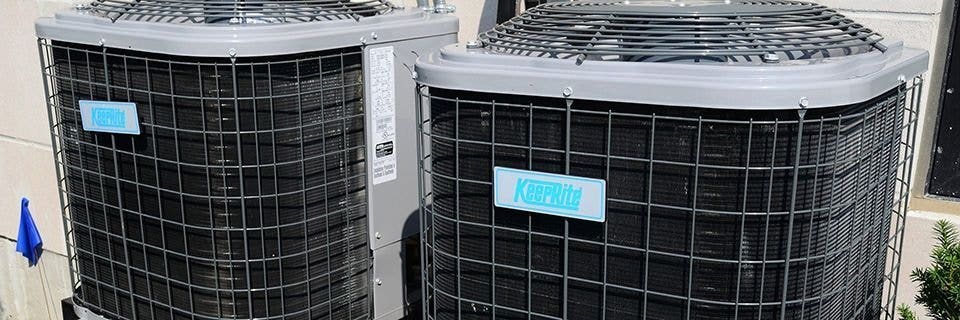- Home
- The Cover Blog
- How to Protect Your Air Conditioner

How to Protect Your Air Conditioner
Share
Sitting outside, your air conditioner unit probably doesn’t get a lot of notice, but it should. When the sun is beating down, your thoughts are restricted to flipping a switch and transforming your home into a cool and comfortable paradise.
Outdoor air conditioners, made from aluminum, copper, and stainless steel, are built to withstand cold winters but they are still vulnerable to exposure. Take these measures into consideration - and understand why your unit isn’t as invincible as you think.
Why You Should Cover Your Outdoor Air Conditioner
Water, Ice, and Snow
Your air conditioner can survive rain showers, but temperature fluctuations can severely damage the unit. Water melting and refreezing on your condenser coils will damage your air conditioner over time. Keep an eye on the weather and cover your AC unit when a snow or ice storm is approaching.
Leaves and Debris
Air conditioners are not built to keep out leaves, seeds, and other debris. Debris in the air conditioner can cause moisture to collect and block moisture drainage. This can cause corrosion, mold, and mildew to grow.
Icicles and Hail Storms
Icicles and hail are perhaps the biggest threats to your air conditioner. Icicles can fall from your roof and damage your air conditioner, and hail can cause dents and interior damage. Check the weather forecast and cover your air conditioner with an armor top cover. These covers have four plates of armor sewn into the cover to give your air conditioner ultimate ice protection.
Why You Need to Find the Right Cover
Mold and Mildew
Using a tarp or makeshift cover to protect your air conditioner can end up doing more harm than good. Low-quality materials are typically not breathable, meaning water can get trapped and cause interior damage. Read more about the importance of breathable covers.
Water can condense and become trapped inside a plastic cover, causing mold and mildew to grow on the air conditioner’s evaporator coils. This can make your air conditioner less efficient by decreasing airflow into your home. It can also cause mold and mildew to enter your home, which can be hazardous and musty smelling. An air conditioner cover with built-in mesh vents lets water evaporate while keeping leaves and debris out.
Keep Out Critters with a Well-Fitting Cover
In the chilly months of fall and winter, rodents and other creatures are on the prowl for warm places to build their nests. If your cover does not completely seal your air conditioner, mice, lizards, and other critters can nest between your air conditioner and cover.
In the process, they can chew up the air conditioner wiring, un-insulated Freon lines, and strip parts. When the heat hits, you’ll be calling a repairman. Invest in a cover that secures at the bottom with a built-in elastic band and heavy-duty strap to keep your AC unit protected.
When to Cover Your Air Conditioner
To know when to cover your air conditioner, first consider where you live. If you live in a mild climate where you use your air conditioner throughout the year, like Florida or Texas, only use an air conditioning cover during severe storms. In areas with drastic seasonal changes, cover your air conditioner in fall and winter.
Types of Air Conditioner Covers
Outdoor Full Air Conditioner Covers
Coverstore's full air conditioner covers are made from hardy, tear-proof, crack-proof, and fade-proof material that protect the air conditioner from damage to keep it running smoothly.
Here are our favorite features of these covers:
- Velcro slits to allow a custom fit around hoses and electrical wires
- An elastic band keeps the cover securely on
- Mesh vents to let water evaporate
Explore our material comparison chart to find the perfect one for you.
Note: These covers cannot be left on while the unit is running.
Outdoor Top Air Conditioner Covers
In some locations, it doesn’t make sense to use a full AC cover. Top air conditioner covers keep debris like leaves and pine needles from getting into your air conditioner and causing blockages.
Coverstore provides two options for top air conditioner covers - mesh covers and armor top covers. One of the biggest benefits of mesh top covers is that they can be left on while the unit is running while still providing protection from falling debris.
Armor top covers provide more protection than mesh top covers, but cannot be left on the unit while it is running. These covers protect your air conditioner by sandwiching four armor plates between two layers of material. Perfect for protecting your air conditioner from icicles and hail, the corners are reinforced with rust-resistant grommets and the cover is secured by heavy duty bungee cords.
Indoor Air Conditioner Covers
Window-mounted and wall air conditioners are not nearly as sturdy as their outdoor counter parts. Even though they at least partly inside, these air conditioners still need protection to keep them running for years to come.
Indoor air conditioner covers prevent dirt, dust, and other debris from entering your air conditioner and clogging it up when it is not in use. They also help keep drafts down if you don’t uninstall your unit during cold winter months.
Note: These covers cannot be left on while the unit is running.
Now that you know the dangers of leaving your AC unit unprotected, it’s time to measure your air conditione so you can find a cover that fits just right.
Want updates on new blog posts, current sales, new product releases, and more? Stay in touch! Like our Facebook page, follow us on Instagram (@thecoverstore), and join Cover Club!